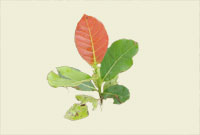HOME » Threats to the Bossou and Nimba chimpanzees
Threats to the Bossou and Nimba chimpanzees
Conservation Efforts
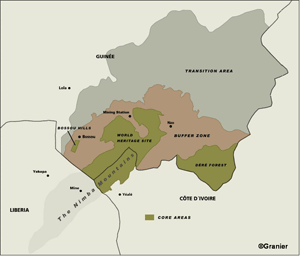
The
Biosphere Reserve of the Nimba Mountains, comprising Bossou,
the Nimba Mountains and Déré forest, harbors many
endemic species of flora and fauna, and is therefore extremely
important area in terms of biological diversity. Development
plans of the sub-region should carefully consider the delicate
balance between environment and economic growth.
As a result of the increased threats facing chimpanzees in West
Africa, a conservation plan has been implemented with the collaboration
of 80 experts (Kormos and al., 2003). Urgent actions are needed
to ensure the survival of West African chimpanzees. The Nimba
Mountains were recognized as one of six top priority sites for
chimpanzee conservation. The site that was recognized extends
across the three national borders comprising Guinea, Côte
d'Ivoire and Liberia, and surrounding forest areas, including
Bossou and Déré in Guinea and Tiapleu in Côte
d'Ivoire. This region is believed to hold an estimated population
of 450 chimpanzees.
The World Heritage Site of the Nimba Mountains is already facing major threats for the conservation of its biodiversity. Many places across the reserve are under pressure from potential mining of iron ore, habitat destruction mainly due to cultivation and indiscriminative poaching using snares and firearms.
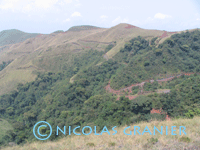
Mineral
resources in Republic of Guinea are very important and diversified.
International mining companies are already exploiting bauxite,
cement, gold, diamonds, iron and salt, but many others like
graphite, limestone, manganese, nickel or uranium are still
untapped. In 2004, all sectors of mining have contributed to
16 % of the Gross Domestic Product in Guinea. It was corresponding
to 25 % of the state public revenue and 80 % of all its exportations.
In this poor developing country, it was representing the most
important sector in terms of income generation and exportation.
Simandou range and Mont Nimba in Guinée Forestière
presents amongst the highest quality of iron deposits known
in the world (iron content was estimated to be between 66 and
68%). The purest iron ore deposit is localized in the northen
part of the Nimba Montains (Guinean part) where a mining enclave
has been delimited. This band of 1 to 3 kilometres large stretches
out the North slope, from the limit of the Reserve core area
up to the crest and even down beyond on the other side the mountain.
In 2003, a mining agreement was signed for the exploitation
of the Mont Nimba iron ore. Exploitation is owned by EURONIMBA
(a new consortium formed by international mining companies),
the Guinean government and SMFG (Société des Mines
de Fer de Guinée).
At present they are drilling in the mining enclave to define
precisely the feasibility and potential sub-sites of exploitation.
The industrial exploitation would not effectively begin before
a minimum time of 8 years.
Mining would have dramatic consequences on the environment and
on chimpanzees in the region. Resulting influx of people will
increase the pressure for cultivation, causing a reduction in
fallow time, further deforestation and higher habitat encroachment.
In addition, mining would likely cause erosion, water pollution
and consequent deterioration of swamp-agriculture rice yields.
This would severely affect local population, which would search
for other income and possibly increased poaching, hunting and
felling of the forest.
A leading cause of rapid and global biodiversity loss in developing countries is the habitat destruction, much of which is due to widespread agricultural development. In Guinea, habitat destruction has been identified as one of the most important factor affecting the chimpanzee survival, by leading to the fragmentation of forest block and therefore isolation of the populations (Kormos and al., 2003). Two main factors have been identified as responsible of environmental degradation. Firstly, the slash and burn agricultural technique which in Guinea is getting more and more threatening for the environment. Secondly, the commercial exploitation of the forest is also a major threat, despite it exists only at little scale in Guinea.
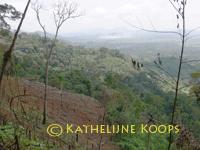
The main agricultural method used in Guinea is consisting in slash and burn culture of mono crops, which requires to frequently changes the cultivated place. Slash and burn agricultural exploitation has strong impact on the environment: parts of the forest are yearly cleared and burned leaving vast surfaces of fallowed land. Core areas of the Nimba Mountains Reserve are not spared in this process, which is resulting in a loss of general biodiversity of the whole massif. Contextual reasons such as demographic growth, farming tools modernization and a critical economical situation are contributing in accelerate this phenomenon.
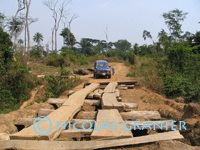
Commercial exploitation of forests can be very destructive in few laps of time. But construction of infrastructures and roads in the framework of this exploitation also has long term negative effects on environmental conservation: it attracts the local people and incites them to install near those facilities where it is easier and less laborious to cultivate. Since the last 20 years, some logging concessions have been sold to international companies by the Guinean government. Although it is not representing an important sector since the wood resource, localized mainly in the south part of the country, is not so abundant. At present the main company working in Guinea is "Forêt Forte" and it has many exploitation concessions localized in a 300 kilometres diameter circle centred on N'Zérékoré. Since 1991, it is considered by the National Comity of MAB (Man & Biosphere Program, UNESCO) and by the local people / authorities, as a central area of the Biosphere Reserve of Mont Nimba. Actually the management plan stipulating this protected status has never been legally completed and accepted. That is how an unscrupulous logging company - Valoris S.A. - took advantage of the situation to build roads and cutting timber inside the forest from 1999 to 2001, justifying its actions with spurious claims of assisting local villages to connect to the road network.
Chimpanzee hunting exists in some regions of Guinea but not in
all. For example, chimpanzees are very rarely killed in the Fouta
Djallon region whereas it is quite common in Guinée Forestière,
two regions known for containing relatively high chimpanzee densities.
In some places of the Nimba Mountains Biosphere Reserve, hunting
pressure seems to be quite important.
Several motivations can lead a local person to hunt a chimpanzee.
It is mainly for their meat which is appreciated by many people
in Guinée Forestière, although some individuals
of specific ethnical groups like the Manon people have cultural
and traditional taboos against eating or killing this animal.
Some cultivators report chimpanzees destroying theirs crops. In
some cases, the chimpanzees are killed for that reason. In period
of fruit scarcity (at the end of the dry season), it is difficult
to find enough food resources in the forest to feed on. Reduction
and fragmentation of the natural habitat is also making this situation
worse, pushing chimpanzees towards the human plantations and fields.
Finally, chimpanzees can be hunted for pet trading. To capture
a young chimpanzee it is necessary to kill at least the mother
who is never abandoning her baby. International and national laws
formally prohibited such practices, but some people are still
doing it.... and others are buying baby chimps.
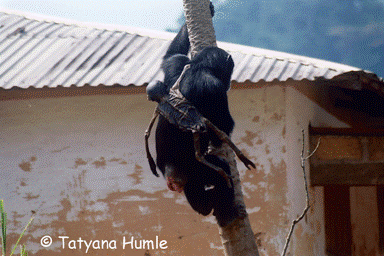
The main cause of death in chimpanzees at many long-term research sites is infectious disease. Because chimpanzees and humans are so similar, chimpanzees may contract many pathogens that are either simply carried by humans or that afflict humans (e.g., tuberculosis, polio, pneumonia, typhoid and Ebola hemorrhagic fever) (Köndgen et al. 2008). If not properly managed, research and tourism present an elevated risk of disease transmission for both species. Chimpanzees are extremely vulnerable to respiratory diseases which have become a major cause of death, especially among habituated populations.
In November 2003, all members of the Bossou community suffered from an outbreak of respiratory disease which resulted in the confirmed death of 4 individuals (2 infants, 1 adolescent male and 1 old adult female) and the presumed death of 1 old adult female. The only other confirmed respiratory disease outbreak at Bossou since 1976 occurred in 1992 and resulted in the death of an infant. Two mothers who had lost their infants to respiratory epidemics carried the mummified body of their young for several weeks thus revealing the strong bond that typically prevails between mother and young in chimpanzees . The 2003 epidemic strongly reminds us of the vulnerability of chimpanzees to human-borne diseases, especially respiratory diseases, and the urgent need to put in place practical measures aimed at preventing the occurrence of similar outbreaks in the future (e.g. compulsory wear of masks when within 20m of the chimpanzees).



